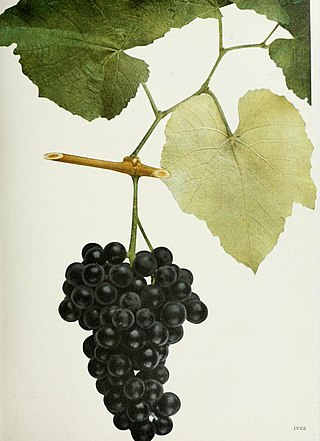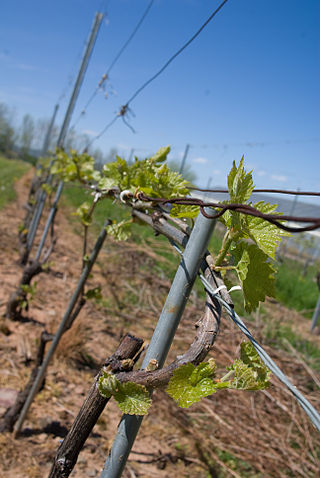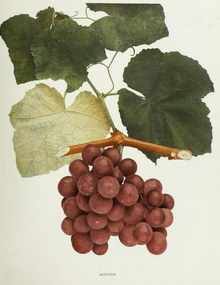
Aurore is a white complex hybrid grape variety produced by French viticulturist Albert Seibel and used for wine production mostly in the United States and Canada. Over a long lifetime, Seibel produced many complex hybrid crosses of Vitis vinifera to American grapes. The Aurore grape is a cross of Seibel 788 and Seibel 29.

Agawam is a hybrid grape variety. It is a crossing of Carter and Muscat Hamburg. Agawam is one of the so-called Rogers' Hybrids created by E.S. Rogers of Salem, Massachusetts, in the early-to-mid-19th century, and is unique among the named cultivars of that group in that it is self-fertile.

Baco blanc or Baco 22A is a French-American hybrid grape variety. It is a cross of Folle blanche and the Noah grape, created in 1898 by the grape breeder François Baco. Folle blanche is its Vitis vinifera parent. Noah, its other parent, is itself a cross of Vitis labrusca and Vitis riparia.

Vitis labrusca, the fox grape, is a species of grapevines belonging to the Vitis genus in the flowering plant family Vitaceae. The vines are native to eastern North America and are the source of many grape cultivars, including Catawba, Concord, Delaware, Isabella, Niagara, and many hybrid grape varieties such as Agawam, Alexander and Onaka. Among the characteristics of this vine species in contrast to the European wine grape Vitis vinifera are its "slip-skin" that allows the skin of the grape berries to easily slip off when squeezed, instead of crushing the pulp, and the presence of tendrils on every node of the cane. Another contrast with European vinifera is the characteristic "foxy" musk of V. labrusca, best known to most people through the Concord grape. This musk is not related to the mammalian fox, but rather to the strong, earthy aromas characteristic of the grapes that were known by early European-American settlers in the New World. The term "foxy" became a sort of catchall for the wine tasting descriptors used for these American wines that were distinct from the familiar flavors of the European viniferous wines.

Hybrid grapes are grape varieties that are the product of a crossing of two or more Vitis species. This is in contrast to crossings between grape varieties of the same species, typically Vitis vinifera, the European grapevine. Hybrid grapes are also referred to as inter-species crossings or "Modern Varieties." Due to their often excellent tolerance to powdery mildew, other fungal diseases, nematodes, and phylloxera, hybrid varieties have, to some extent, become a renewed focus for European breeding programs. The recently developed varieties are examples of newer hybrid grape varieties for European viticulturalists. Several North American breeding programs, such as those at Cornell and the University of Minnesota, focus exclusively on hybrid grapes, with active and successful programs, having created hundreds if not thousands of new varieties.
Noiret is a hybrid grape variety used in red wine production. It was developed and named by Cornell University researchers working at the New York State Agricultural Experiment Station, and was officially released on July 7, 2006.
Rogers' Hybrids are a group of 45 grape seedlings, thirteen of them named as cultivars, developed by Edward Staniford Rogers of Salem, Massachusetts, in the mid-19th century. Although almost entirely gone from cultivation now, their success, along with that of the Concord grape, inspired many amateurs to try grape breeding, resulting in massive proliferation in the number of grape cultivars in the eastern United States and Canada.
Requa is one of the lesser known members of the collection of grape varieties known as Rogers' Hybrids, created by Edward S. Rogers of Salem, Massachusetts in the mid-19th century, and is the result of a cross of Carter, a selection of Vitis labrusca, and Black Hamburg, a selection of Vitis vinifera. It was originally known as Rogers No. 28, until Rogers named it after a James Augustus Requa, agent for Thomas Lake Harris' utopian winegrowing community of 'Salem-on-Erie' at Brocton, New York. Requa is female, and thus requires a second grape variety as a pollen source. Fruit is a dark red, ripens late, and is prone to rot.

Herbert is one of the collection of grape varieties known as Rogers' Hybrids, created by Edward Staniford Rogers in the mid-19th century, and is the result of a cross of Carter, a selection of Vitis labrusca, and Black Hamburg, a selection of Vitis vinifera. It was originally known as Rogers No. 44.

Massasoit is one of the collection of hybrid grape varieties known as Rogers' Hybrids, created by E.S. Rogers of Salem, Massachusetts, in the mid-19th century, and is the result of a cross of Carter, a selection of Vitis labrusca, and Black Hamburg, a selection of Vitis vinifera. It was originally known as Rogers No. 3, but in 1869 Rogers named it after a prominent Native American chief from early Massachusetts history, Ousamequin, who used the title Massasoit.

The Isabella grape is a cultivar derived from the grape species Vitis labrusca or 'fox grape,' which is used for table, juice and wine production.

Vitis (grapevine) is a genus of 81 accepted species of vining plants in the flowering plant family Vitaceae. The genus consists of species predominantly from the Northern Hemisphere. It is economically important as the source of grapes, both for direct consumption of the fruit and for fermentation to produce wine. The study and cultivation of grapevines is called viticulture.
Black Spanish is a variation of grape that was originally assumed to be a seedling of an American hybrid grape which resulted from the crossing of the American Vitis aestivalis species with that of an unknown Vitis vinifera. The vinifera is suspected to have been the pollen donor.

Olmo grapes are wine and table grape varieties produced by University of California, Davis viticulturist Dr. Harold Olmo. Over the course of his nearly 50-year career, Dr. Olmo bred a wide variety of both grapes by means of both crossing varieties from the same species or creating hybrid grapes from cultivars of different Vitis species.
Cascade is a red complex hybrid grape variety that was created by French viticulturist Albert Seibel in the early 20th century in Aubenas, Ardèche, in the Rhône Valley. It has been commercially available in North America since 1938 and has since been planted in Canada and the United States. However, in warmer climates, the grape is highly susceptible to a number of grapevine viruses, which has discouraged plantings of the variety.

Ives noir is a red hybrid grape variety that is grown throughout the United States. Named after its propagator, Connecticut wine grower Henry Ives, the grape's pedigree and exact origin are unclear. After Prohibition in the United States, Ives was a popular grape used in the production of sweet port-style wines but saw its plantings steadily decrease throughout the 20th century as the vine's susceptibility to air pollution took its toll.

L'Acadie blanc is a white Canadian wine grape variety that is a hybrid crossing of Cascade and Seyve-Villard 14-287. The grape was created in 1953 by grape breeder Ollie A. Bradt in Niagara, Ontario at the Vineland Horticultural Research Station which is now the Vineland Research and Innovation Centre. Today the grape is widely planted in Nova Scotia with some plantings in Quebec and Ontario. Some wine writers, including those at Appellation America, consider L'Acadie blanc as "Nova Scotia’s equivalent to Chardonnay".

The propagation of grapevines is an important consideration in commercial viticulture and winemaking. Grapevines, most of which belong to the Vitis vinifera family, produce one crop of fruit each growing season with a limited life span for individual vines. While some centenarian old vine examples of grape varieties exist, most grapevines are between the ages of 10 and 30 years. As vineyard owners seek to replant their vines, a number of techniques are available which may include planting a new cutting that has been selected by either clonal or mass (massal) selection. Vines can also be propagated by grafting a new plant vine upon existing rootstock or by layering one of the canes of an existing vine into the ground next to the vine and severing the connection when the new vine develops its own root system.
Blanc du Bois is an American hybrid grape that was created in 1968 by John A. Mortensen at the University of Florida’s Central Florida Research and Education Center in Leesburg, Florida. Mortensen created this variety by crossing various Vitis vinifera grape varieties such as Golden Muscat with native Florida varieties. When released in 1987, Blanc du Bois became another grape variety in the small but growing number of vine types that can both produce marketable wine on their own yet can withstand Pierce's Disease, a bacterial infection that destroys nearly all vinifera vinestocks imported into the southern United States.













